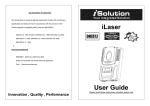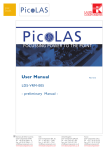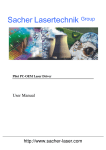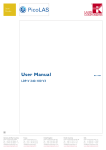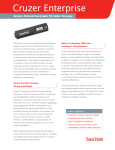Download - Schulz Electronic GmbH
Transcript
User Manual Rev. 13.12 LDS-VRM-005 - preliminary Manual - Distribution 1 Table of Contents Table of Contents ....................................................................................................................... 2 How to use the Manual .............................................................................................................. 3 Absolute Maximum Ratings (destroying limits) ............................................................................ 3 Dos and Don’ts ........................................................................................................................... 4 How to get started...................................................................................................................... 5 Required Laser-Diode Pinout ....................................................................................................... 6 Required electrical characteristics of the Laser-Diode................................................................... 6 Description of the Connectors of the LDS-VRM 005.................................................................... 7 Input (#2) and Current Monitor (#1) ........................................................................................... 8 Propagation delay (#2 to #1)....................................................................................................... 9 Description of the SUB-D 9 Connector (#3) ................................................................................. 9 Power Supply (#3) and Supply Absolute Maximum Ratings ....................................................... 10 Block Diagram .......................................................................................................................... 10 Description of BIAS POT (#3)..................................................................................................... 11 Linearity.................................................................................................................................... 12 Cooling..................................................................................................................................... 14 Test Load .................................................................................................................................. 15 Mechanical Dimensions ............................................................................................................ 16 2 How to use the Manual Remark: Remark: The LDS LDS-VRM VRM-005 described in this manual is a basebase-plate cooled laser diode driver. driver. Base plate cooling: cooling: Depending on the final application and operation regime, this unit may stay uncooled uncooled or must be assembled onto a heat sink. Please refer to chapter Power dissipation for more details about the thermal power losses during operation. You me use a passively or an actively air/water cooled device. Housing: All units are delivered with housing. Changes Changes are possible; the units can be delivered without housing upon request. Before powering on your unit, read this manual thoroughly and make sure your understood it fully. Please pay attention to all safety warnings. If you have any doubt or suggestion, suggestion, please do not hesitate to contact us! Absolute Maximum Ratings (destroying limits) All Input Pins must not exceed the voltage range below zero (GND) and beyond VCC VCC Limit: Refer to table in chapter “Power Supply (#3)” Peak output current: 0.5 A Max Imon current: 10mA Operating temperature range: + 0 °C .. + 60 °C Best performance operating temperature range: + 10 °C .. + 35 °C Storage temperature range: - 20 °C .. + 70 °C 3 Dos and Don’ts Never ground any output connector. Never use any grounded probes at the output. Do not connect your oscilloscope to the output! This will immediately destroy the driver and the probe! Keep connecting cables between power supply and driver as well as the connection between driver and laser diode as short as possible. Mount the driver on an appropriate heat sink! Please be aware that there might be hot surfaces, be careful not to touch them! 4 How to get started You need an additional fast arbitrary waveform generator (AWG) which has to be connected to the Input MMCX-Terminal. There is no AWG on board of the driver! The PCB is very thin. Mechanical forced have to be avoided to prevent damage. Mechanical damages are not covered by warranty. Step # 1 2 3 4 5 6 7 8 What to do Check Assemble the driver onto an appropriate heat sink Solder a dummy-diode between LD+ and LD-pad, alternatively make a short circuit there. Connect GND, +15V Vcc (Power Supply disabled). Connect AWG or pulse generator on Input Terminal (no pulse before power supply enabled). Enable the power source for +15V Vcc and feed a Pulse on the input terminal. For example 0.5 V amplitude 1 µs pulse width and 300 µs repetition rate. Check it whether the Current Monitor Output pulses shape is similar to the input signal. Disable the input signal and turn the power sources for +15V Vcc. Take out the test-diode or bypass. Assemble the final laser diode. Turn the power supply for the +15V Vcc on and feed a Pulse on the input terminal. 5 Refer to Chapter “Test Load” Required current for this step is around 18 mA Refer to all chapters referencing Input (Connector #1) Make sure not to overload the laser diode or the driver. On Imon-Output (Connector #2) you can measure a signal comparable with the input signal. 1.0 V on the input terminal results a current of 500 mA by test-diode or bypass and 400 mV on the Imon-Output. Use an oscilloscope with a 50 ohm termination. Required Laser-Diode Pinout The LDS-VRM-005 is designed for the direct connection of almost any kind of laser diode. The landing patterns accept 2 and 3 terminal packaged Laser-Diodes. Never use cables > 10nH. This will cause excessive ringing and may damage the LD. Laser Diode Connection: the rectangular Pads on top (Cathode) and bottom (Anode). The dimensions of the rectangular Pads are 1 mm x 5 mm. There is no optical feedback path. The unit is current controlled, only. Please shorten the legs to avoid short circuits inside the driver The maximum internal stray impedance must not exceed ~ 10 nH to achieve best performance Required electrical characteristics of the Laser-Diode: Parameter Laser Diode Forward Voltage Laser Diode Forward Voltage Comment Pulse mode CW mode 500 mA 6 min 0V 0V typ 1.8 V 1.8 V Max 6V 3V Description of the Connectors of the LDS-VRM 005 #1 #2 #3 Connector #1 Function Signal input Assembled Type SMC, male MULTICOMP 1169655 You need: SMC, female #2 Current monitor (Output) SMC, male MULTICOMP 1169655 SMC, female #3 Power connector D - Sub 9 male D - SUB9 female on cable: Harting 0966118 7500 7 Input (#1) and Current Monitor (#2) The driving analogue signal is provided via Connector #1. The output current is following the input signal within the limitations (bandwidth, max. current, rise time) proportional (refer to Chapter “Linearity”). 8 Propagation delay (#1 to #2) The typical propagation delay from input to start of current flow is typ. 10 ns. Additional 8 ns appear through the internal current monitor. Description of the SUB-D 9 Connector (#3) Pin SUB-D 9 Connector 1 2 3 4 5 6 7 8 9 GND BIAS POT1_2 BIAS POT1_1 NC NC NC 15V Vcc GND 15V Vcc 9 Power Supply (#3) and Supply Absolute Maximum Ratings The laser driver supply can be interrupted at any time for e.g. safety reasons. Pin of conn. #3 7 and 9 (15V Vcc) 1 and 8 (GND) Allowed range 15 V … 24 V GND Best performance 15 V GND Block Diagram 10 Destroying limit 25 V Description of BIAS POT (#3) Bias Potentiometer P1 P1 Bias This Value of Potentiometer P1 is part of the calibration procedure performed at PicoLAS. It must not be changed by customer. Changes have an impact on the performance of the driver and may damage the LD and the driver. All changes are monitored and will cause the lost of the warranty. The factory settings provide the Bias current to 15 - 20mA. This current flows always through the laser diode. BIAS_POT Connector To increase the Bias current, an additional resistor can be connected externally. Resistance value on pin 2 and pin 3 of connector #3 sets the Bias current for the control unit. Reduction of the total resistance results an increase of the Bias current. A short circuit between the Pin 2 and 3 would be increase the Bias current in level of 500 mA. Use as example a resistor Rext and potentiometer Pext in series. The resistor Rext set the maximum and Pext the minimum of Bias current. Rext=1k for 150 mA Bias current. There can not be set as the factory settings smaller Bias current of 15 - 20mA. 11 If the increase of Bias current is not necessary let the pin 2 and 3 floating. Linearity current-voltage characteristic pulse mode 500 450 ILaser Diode / mA 400 350 300 250 200 150 100 50 0 0 100 200 300 400 500 Uin/mV 12 600 700 800 900 1000 current-voltage characteristic cw mode 500 450 400 350 Ild/mA 300 250 200 150 100 50 0 0 25 50 75 100 125 Uin/mV 13 150 175 200 225 250 Frequency Response Vcc = 15V, Output Current = 125 mA, Testload = short circiut . Output Current Frequency Response 9 6 Iout Signal in dB 3 0 -3 -6 -9 -12 -15 -18 1 10 100 1000 f - Frequency - MHz Current Monitor Frequency Response 21 18 15 12 Imon Signal in dB 9 6 3 0 -3 -6 -9 -12 -15 -18 -21 -24 -27 -30 1 10 f - Frequency - MHz 14 100 1000 Cooling The seed driver is base plate cooled only. Please assemble the entire unit to a heatsink which is capable to take out the heat. The heatsink is suitable, if the system temperature does not exceed the maximum operating limits. To achieve best performance the base plate temperature should be kept in the range of + 10 °C … + 35 °C. The peak heat load is 10 W. Test Load For the first testings a test load may be assembled instead of the laser diode. This test load may be a short circuit or a fast schottky diode like MBR0540. Please connect the test load only between Anode and Cathode (LD+ and LD-) and prevent shorts to any other part of the circuit. The connections for LD+ are at the bottom and for LD- on the top side. 15 Mechanical Dimensions The following dimensions are in millimetres (mm). A 54 B 35,5 C 27 D 18,5 E 63 F 30 G 23,5 H 23 I 11 J 5 K 6,7 L 6 16 The following dimensions are in millimetres (mm). A 54 O 2,3 B 53,25 P 6,5 C 50 Q 2,3 D 46,75 E 7,25 F 4 G 0,75 H 63 I 60 J 59 K 4 L 21,5 M 32,5 N 5 17

















